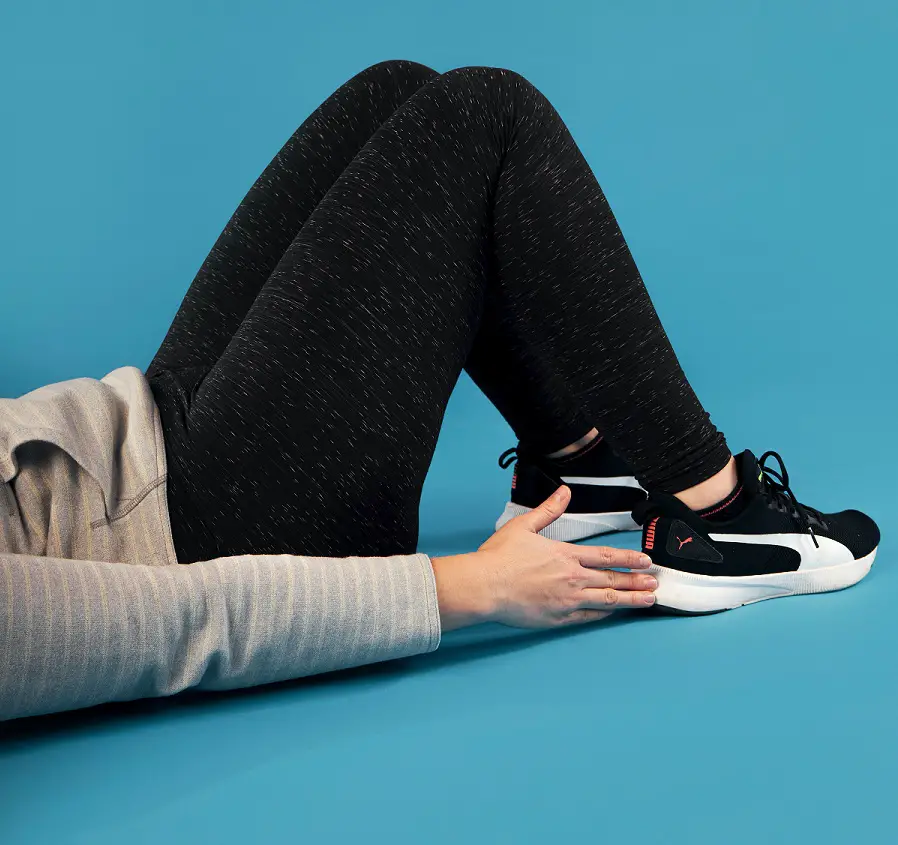As a mom of 4 children within 5 years, my body had some serious recovering to do (including diastasis recti exercises that I didn’t even know I needed to do until recently). I never knew the extent at which our bodies actually change, stretch, grow and weaken after each pregnancy. It wasn’t until after my 3rd baby and an amazing midwife, that I learned I had Diastasis Recti and was at high risk of developing an abdominal hernia. Add this to the list of things no one prepares you for when you bring a baby into the world!
What is Diastasis Recti (DR)?
To put into perspective that I had no idea what our bodies actually endure during pregnancy, I had never even heard the words Diastasis Recti before. I know how valuable and important this information is now, so I want you to be empowered with everything you need to know to avoid the discomfort I went through for 3 years.
DR is the separation of your “six pack,” abdominal muscles after labor & delivery. When your baby is developing, your uterus stretches, causing your abdominal muscles to stretch and make room. After your baby is born, those muscles usually shrink back down. Sometimes, they don’t come together like they used to be and that leaves an open space in the upper, mid or lower abdominal muscles. In more severe cases it can leave an opening that extends from the upper to lower abdominal muscles, and these cases may require surgery to correct the problem depending on the size of the separation. Diastasis Recti leaves you at risk for abdominal hernias, pelvic floor dysfunction, loss of bladder control, back pain and more.
This condition is more noticeable postpartum, but it can happen during pregnancy as well. It’s also important to note, this condition is not limited to pregnancy or postpartum only. It can also affect newborn babies and men.
Causes of Diastasis Recti
During pregnancy, DR can develop from heavy lifting or pregnancy with multiples. Pregnancy hormones like relaxin and estrogen make it easier for diastasis recti to occur as well. Pushing during delivery can create excessive inner-abdominal pressure, which can lead to DR.
It is estimated that 70% of pregnant women develop this condition during or after pregnancy. Depending on the severity of the muscle separation, most women have some degree of abdominal bloating, ridge down the midline when flexing or protrusion. This is sometimes referred to as “mom pooch” and it may look like a belly in early pregnancy.
For women who’ve had a cesarean delivery, your muscles are stretched even more than in natural deliveries. During a C-section, your abdominal muscles are not usually cut, they are separated along the midline for easier access to the uterus. After your baby is delivered, your uterus is sutured closed and some surgeons will place a few stitches in the abdominal muscles to bring them back together. Research now shows that stitching the muscles back together is not necessary and it can sometimes cause the muscles to tear.
The good news is, there are exercises you can do to help your abs come back together and the majority of DR cases heal on their own. It’s estimated that only about 35% of women will still have significant separation in their abdominal muscles 6 months postpartum!
How Do I Know If I Have Diastasis Recti & Risk Factors
DR can be congenital, which means someone has had it since birth. In pregnancy, multiple babies, pregnancies back to back, height, heavy lifting and pushing excessively during delivery can all contribute to higher chances of developing diastasis recti. In the early postpartum period, it can be caused by heavy lifting, too soon.
The most common sign of having diastasis recti, is a midline bulge down the middle of your abdomen. Sometimes this may be the only sign that there is a separation in the abdominal muscles. Other signs & symptoms to look out for include:
- Lower back pain
- Loss of bladder control
- Pelvic floor weakness – which can cause pelvic organ prolapse (when one or more organs slip down and bulge into the vagina)
- Discomfort/pain in the abdomen or pelvis
- Pelvic pain during intercourse
- Abnormal bowel movements
You can do a simple self-check if you suspect DR. You’ll measure by finger width. First you’ll want to lay down on a flat surface and lift your head slightly, place your two fingers 1-2 inches above your belly button and gently press down to feel for a space between the abdominal muscles. If you feel 2 or more finger width’s space, there is likely a separation. This would be a great self-check to do before your usual 6 week postpartum visit with your doctor or midwife and before jumping back into normal exercise. Your doctor can measure to confirm if there is in fact a separation of the muscles and can give you a definitive diagnosis. They will also be the one to let you know your body is ready to start normal exercises or if there needs to be modifications.
Can Diastasis Recti Exercises Correct The Problem?
There are great exercises that can support those muscles as they move closer together! I’ll share some basic exercises and stretches for you to try and I’ll share my favorite free resource for more!
A good rule of thumb to remember is, any exercise you do if you have DR should not push your abdominal muscles out. For example:
Sit-ups, planks and push-ups push those ab muscles out. If you lay flat on your back with knees bent and hands at your sides, then lift your bottom, it will pull your ab muscles in.
Simple exercises or stretches that you can try include:
- Lay on your back with your knees bent, lift your pelvis slightly, hold for 5 seconds and release. Repeat 5 to 10 times. This helps your pelvic floor muscles come closer to your abdominal muscles, encouraging them to gently come back together.
- Heel Taps – lying flat on your back, you’ll raise one arm over your head and lift one leg up, breathing in as you lift and exhaling as you lower. Repeat this with the opposite leg and arm, 10 times each. Remember to keep your back flat and pelvis tilted towards your belly button
If you’re wondering, “How long does it take to fix diastasis recti?” Healing usually takes a few months, so it’s important to give yourself grace and have patience through the process. You will start to feel better in just a few weeks and you’ll notice a difference in how your abdomen starts to look & feel. When I first started the healing process, I noticed I felt less bloated in just the first week!
My personal favorite resource for DR workouts is Bodyfit By Amy on Youtube. I love her Diastasis Recti playlist of videos. She has a playlist full of pregnancy safe workout videos, as well as hundreds of other styles of exercise. The best part is, they’re all free!

Natural Ways To Fix Diastasis Recti
In addition to gentle exercise, there are a few more options to naturally repair diastasis recti. The best tip my mom shared with me was wearing an abdominal support belt or binder. Sometimes our muscles need a little more support to come back together and a support belt or binder can keep those muscles pulled tightly together and can also keep the condition from worsening due to poor posture or poor form when lifting. If you are newly postpartum and had a c-section, make sure to ask your healthcare provider when would be the best time to start wearing any kind of support belt. Putting one on too soon could interfere with the incision site and healing.
Physical therapy may be suggested if your doctor measures over two finger widths separation in the abdominal muscles. Physical therapy is a great tool and can help speed up healing time as well as boost pelvic floor health. While it may be uncomfortable to talk about symptoms from pelvic floor issues, DR might be the root cause and it could improve your quality of life by getting the proper help and support to heal.
Avoid increased abdominal pressure, especially in the early postpartum period. Avoid lifting heavy objects, including carrying toddlers. This strains the connective tissue between your ab muscles, which will widen the gap between those muscles.
Be mindful of your posture. Keeping your spine aligned as much as possible, will help to correct the problem on its own. Lastly, make sure to let yourself rest. You might think that’s easier said than done, especially with a new baby, but if you get those windows of time to lay down and relax for a few moments your body will get rest it needs to heal.
Foods to avoid with Diastasis Recti
Have you heard the saying, “Food is medicine?” Certain foods can also have the opposite effect, so it’s important to be aware of what to avoid and what to look for that supports healing in the body. Good nutrition can have a positive effect on muscle tone, hair shine, skin appearance, bone & joint health, our emotions and energy levels.
Good nutrition assists the body’s natural healing processes for quicker recovery, while bad nutrition can create inflammation in the body that can slow down those natural healing processes.
Diastasis recti is a problem with connective tissue and muscle, so you want to consume nutrients and foods that support healthy elasticity and collagen production. Vitamins C & A and Zinc are important for collagen regeneration. Protein also plays an important role in repairing damaged tissue. Water is important for hydrating connective tissue.
More FAQs for Diastasis Recti
- Are squats safe for diastasis recti? Squats are beneficial and safe if you are dealing with DR, if done correctly. This means making sure your core is engaged & supported, and being mindful not to push out during the exercise
- Does insurance cover diastasis recti treatment or surgery? This varies widely between insurance companies and they usually only cover medically necessary treatments or procedures, so this might depend on the diagnosis & severity your doctor has stated.
- Is walking good for diastasis recti? Walking is good for diastasis recti when the core muscles are engaged and you are keeping your spine in good, upright posture.
- Can diastasis recti be fixed years later? It’s never too late to build that core muscle strength. Through consistent exercise, support and nutrition, you can heal and improve connective tissue health and muscle tone.
There are so many resources and tools available to postpartum mothers and I hope this information empowers you to take action or feel hopeful that your body can heal! The most important thing to remember, is to give yourself grace. This is a process, but you will start to feel more like yourself in a few short months!
You can follow me on Instagram here.

